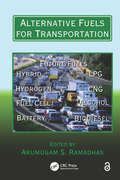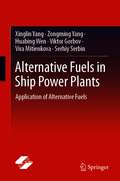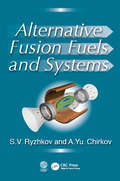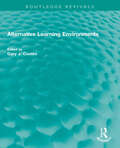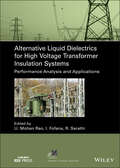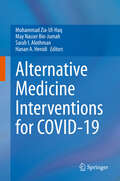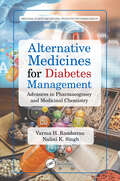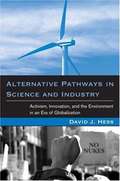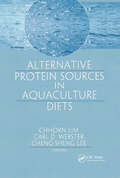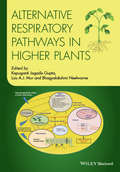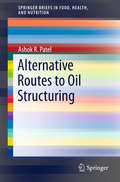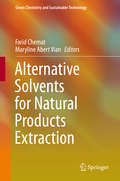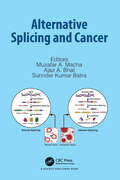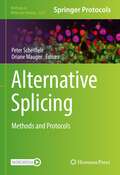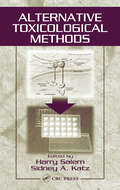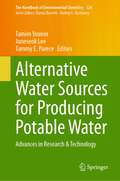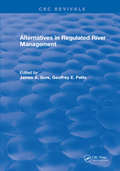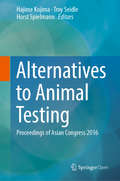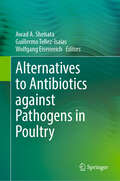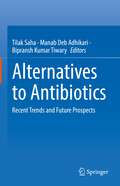- Table View
- List View
Alternative Fuels for Transportation
by Arumugam S. RamadhasExploring how to counteract the world's energy insecurity and environmental pollution, this volume covers the production methods, properties, storage, engine tests, system modification, transportation and distribution, economics, safety aspects, applications, and material compatibility of alternative fuels. The esteemed editor highlights the importance of moving toward alternative fuels and the problems and environmental impact of depending on petroleum products. Each self-contained chapter focuses on a particular fuel source, including vegetable oils, biodiesel, methanol, ethanol, dimethyl ether, liquefied petroleum gas, natural gas, hydrogen, electric, fuel cells, and fuel from nonfood crops.
Alternative Fuels in Ship Power Plants: Application of Alternative Fuels
by Zongming Yang Huabing Wen Xinglin Yang Viktor Gorbov Vira Mitienkova Serhiy SerbinThis book describes the feasibility and status of the use of alternative fuels in marine engineering, as well as the application of liquefied natural gas, biodiesel and their blends as marine fuels, and the combustion of synthetic coal-based fuels.Each chapter in the book ends with a summary, which gives the reader a quick and clear understanding of the main contents of the chapter. The book gives a lot of advice on the selection of equipment and parameters, fuel reserves and preparation for scholars related to alternative fuels in ships, and points them in the way. It contains lots of illustrations and tables and explains it in the form of chart comparison. The authors have developed mathematical models and methods for calculating the parameters of fuel systems for biodiesel fuels and liquefied natural gas. Recommendations for choosing the rational parameters of these systems are given, as are schematic solutions of the fuel systems, recommendations for selecting equipment, storing, and preparing the fuels. Application of the materials described in the book provides the SPP designers with a reliable tool for choosing rational characteristics of the fuel systems operating on alternative fuels and improving the efficiency of their application on ships.
Alternative Fusion Fuels and Systems
by Sergei V. Ryzhkov Alexei Yu. ChirkovExplores the systems of magnetic confinement of high-temperature plasma with closed and open magnetic field lines which relate to alternative compact devices of controlled thermonuclear fusion. Energy balance schemes of thermonuclear plasmas and main reactor characteristics are presented as the authors compare conceptual projects based on classical tokamak and stellarator, spherical tokamak and compact torus. They explore the questions and problems of new promising nuclear and thermonuclear power plants that source thermonuclear neutrons on a mixture of deuterium and tritium, and a low-radioactive reactor on a mixture of deuterium and helium-3.
Alternative Learning Environments (Routledge Revivals)
by Gary J. CoatesOriginally published in 1974, this volume presents viable alternatives to traditional attitudes and practices in environmental design and education. It contains 29 selections that reflect the thought and actions of leaders from many diverse disciplines and professions. Architects, landscape architects, urban planners, teachers and administrators, psychologists and social theorists address themselves to controversial and important issues facing our post-industrial society. The range of subjects explored in the volume is far-reaching: • Environmental education in which the art of planning and designing itself becomes the curriculum • Advocacy planning and community participation in bo9th educational and design decision making • Alternative educational institutions, ranging from community-centered schools and mobile schools to non-school learning networks that distribute the learning activity throughout the fabric of the city and the lifetime of the learner. • New developments in systematic design methods and evaluation research that promise to make the design process more public and responsive to the user-client.
Alternative Liquid Dielectrics for High Voltage Transformer Insulation Systems: Performance Analysis and Applications (IEEE Press Series on Power and Energy Systems)
by U. Mohan Rao I. Fofana R. SarathiA comprehensive reference and guide on the usage of the alternative dielectric fluids for transformer insulation systems Liquid-filled transformers are one of the most important and expensive components involved in the transmission and distribution of power to industrial and domestic loads. Although petroleum-based insulating oils have been used in transformers for decades, recent environmental concerns, health and safety considerations, and various technical factors have increased the need for new alternative and biodegradable liquids. Alternative Liquid Dielectrics for High Voltage Transformer Insulation Systems is an up-to-date reference and guide on natural and synthetic ester-based biodegradable insulating liquids. Covering the operational behavior, performance analysis, and maintenance of transformers filled with biodegradable insulating liquids, this comprehensive resource helps researchers and utility engineers expand their knowledge of the benefits, challenges, and application of ester-filled transformers. In-depth chapters written by experienced researchers addresses critical topics including transformer condition monitoring, high voltage insulation testing, biodegradable insulating material processing and evaluation, and more. A unique and significant contribution to existing literature on the subject, this authoritative volume: • Covers condition monitoring, diagnostic testing, applications, maintenance, and in-service experiences • Explores current challenges and future prospects of ester-filled transformers • Discusses significant research progress and identifies the topics in need of further emphasis • Compares the differences and similarities between mineral oils and ester liquids • Includes in-depth behavioral observations and performance analysis of ester-based insulating liquids Alternative Liquid Dielectrics for High Voltage Transformer Insulation Systems: Performance Analysis and Applications is a must-have reference for utility engineers, electrical power utilities, transformer owners, manufacturers, and researchers.
Alternative Medicine Interventions for COVID-19
by Muhammad Zia-Ul-Haq May Nasser Bin-Jumah Sarah I. Alothman Hanan A. HenidiThis research volume examines the available alternative, complementary, pharmaceutical and vaccine methods for treating, mitigating, or preventing COVID-19. Coverage includes traditional Chinese medicine, herbal remedies, nutraceutical/dietary options, and drug/vaccine therapies. All the methods discussed will be critically examined to provide readers with a full, unbiased overview that includes pros/cons of each method. While the nature of COVID-19 is still being studied, and new research and theories are being published daily, this book endeavors to provide readers with a comprehensive summary of current research on alternative and mainstream treatment and prevention methods.
Alternative Medicines for Diabetes Management: Advances in Pharmacognosy and Medicinal Chemistry (Medicinal Plants and Natural Products for Human Health)
by Varma H. Rambaran Nalini K. SinghApart from diet and exercise, the strategic use of different classes of prescribed or non-prescribed xenobiotic compounds for the restoration of euglycemic levels in the body is well known. The ongoing rivalry between the recommended usage of allopathic medicines versus ayurvedic remedies has encouraged many researchers to focus their studies on thoroughly isolating and characterizing the extracts from different parts of plants and then evaluating their relative activities via in vitro, in vivo and in some cases clinical studies. Alternative Medicines for Diabetes Management: Advances in Pharmacognosy and Medicinal Chemistry provides a holistic view of all oral therapies for diabetes mellitus that are available to the public by removing the silos and stigmas that are associated with both allopathic and ayurvedic medicines. Additional Features Include: Highlights the potential role of dietary and medicinal plant materials in the prevention, treatment, and control of diabetes and its complications. Educates readers on the benefits and shortcomings of the various present and potential oral therapies for diabetes mellitus. Allows quick identification and retrieval of material by researchers learning the efficacy, associated dosage and toxicity of each of the classes of compounds. Presents the history, nomenclature, mechanisms of action and shortcomings for each of the various sub-classes of allopathic therapeutants for diabetes mellitus and then introduces ayurvedic medicines. Section C discusses various metallopharmaceuticals and provides a holistic view of all available and potential therapies for the disease.
Alternative Pathways in Science and Industry: Activism, Innovation, and the Environment in an Era of Globalization
by David J. HessHess examines how social movements and other forms of activism affect innovation in science, technology, and industry. Hess explores the interaction of grassroots environmental action and mainstream industry and offers a conceptual framework for understanding it.
Alternative Protein Sources in Aquaculture Diets
by Cheng-Sheng Lee Chhorn Lim Carl D. WebsterA unique resource that describes the ingredients included in an aquaculture diet, species profiles, processing methods, impacts to environment and industry, and more. Aquaculture is and will remain a major food producing sector in the future. To become more efficient and successful in the aquaculture industry, operations need to provide good nutrition. Alternative Protein Sources in Aquaculture Diets is a unique source describing the ingredients included in fish and crustacean diets, their nutrient compositions, species profiles, suitability for species, processing methods, and impacts of alternative ingredients on the environment and to the aquaculture industry. World-renowned nutritionists and feed technologists explore practical ways for the aquaculture industry to expand and remain competitive, and discuss ways to develop less expensive alternative sources or protein. Diet costs take up a huge chunk of operating expenditures, with fish meal being one of the most expensive ingredients in the aquaculture diet. Alternative Protein Sources in Aquaculture Diets provides detailed knowledge on the use of alternative plant and animal protein sources, offering opportunities to either partially or completely replace fish meal. This comprehensive, up-to-date text discusses the most widely used ingredients as well as various previously under-utilized ingredients which could be of significant potential in the future. The book is extensively referenced and includes numerous helpful tables to clearly present data. Topics discussed in Alternative Protein Sources in Aquaculture Diets (for finfish and crustacean species) include: • farmed fish diet requirements • reduction of waste through diet formulation • poultry by-product meal • meat packing by-products • soybean protein foodstuffs • cottonseed meal • lupins • unconventional plant protein supplements.
Alternative Respiratory Pathways in Higher Plants
by Bhagyalakshmi Neelwarne Luis A. Mur Kapuganti Jagadis GuptaRapid developments in molecular and systems biology techniques have allowed researchers to unravel many new mechanisms through which plant cells switch over to alternative respiratory pathways.This book is a unique compendium of how and why higher plants evolved alternative respiratory metabolism. It offers a comprehensive review of current research in the biochemistry, physiology, classification and regulation of plant alternative respiratory pathways, from alternative oxidase diversity to functional marker development. The resource provides a broad range of perspectives on the applications of plant respiratory physiology, and suggests brand new areas of research.Other key features: written by an international team of reputed plant physiologists, known for their pioneering contributions to the knowledge of regular and alternative respiratory metabolism in higher plants includes step-by-step protocols for key molecular and imaging techniques advises on regulatory options for managing crop yields, food quality and environment for crop improvement and enhanced food security covers special pathways which are of key relevance in agriculture, particularly in plant post-harvest commodities Primarily for plant physiologists and plant biologists, this authoritative compendium will also be of great value topostdoctoral researchers working on plant respiration, as well as to graduate and postgraduate students and university staff in Plant Science. It is a useful resource for corporate and private firms involved in developing functional markers for breeding programs and controlling respiration for the prevention of post-harvest losses in fruit, vegetables, cut flowers and tubers.
Alternative Routes to Oil Structuring (SpringerBriefs in Food, Health, and Nutrition)
by Ashok R. PatelThis Springer Brief gives an overview of recent research conducted in the area of oil structuring starting with a detailed introduction on oleogelation and properties of food-approved building blocks followed by the discussion of some illustrative examples to explain the processing steps required for creating oleogels, advanced characterization (rheological, thermal and microstructural) and some potential edible applications of oleogels. The book w concludes with a section summarizing the general guidelines on the properties of oleogels and practically of approach with regards to the specific category of building blocks used for structuring. The text also lists some unresolved challenges that need to be addressed in order to fully exploit oleogelation for future food product development. The functional application of liquid oils in food product development is mostly accomplished by structuring them into soft, plastic-like materials. This structuring of oil is traditionally based on the fat crystal network formed by high melting triacylglycerol (TAG) molecules that are rich in trans and/or saturated fatty acids. Currently, due to the factors such as the requirement for trans- and saturated fat-free food products, sustainable manufacturing and ethical trade practices, the research in the area of identifying alternative routes to oil structuring (in the absence of trans and saturated fats) has been regarded as a 'hot topic' in the bio-scientific community. Oleogelation (gelling of liquid oil in absence of crystallizable TAGs) is one such alternative, which has recently attracted tremendous attention from researchers and industrial scientists working in the domain of food product development. The possibility of creating structured gels that contain a large amount of liquid oil (usually above 90 wt%) opens up many possibilities to develop food products with better nutritional profiles.
Alternative Solvents for Natural Products Extraction (Green Chemistry and Sustainable Technology)
by Farid Chemat Maryline Abert VianThis book presents a complete picture of the current state-of-the-art in alternative and green solvents used for laboratory and industrial natural product extraction in terms of the latest innovations, original methods and safe products. It provides the necessary theoretical background and details on extraction, techniques, mechanisms, protocols, industrial applications, safety precautions and environmental impacts. This book is aimed at professionals from industry, academicians engaged in extraction engineering or natural product chemistry research, and graduate level students. The individual chapters complement one another, were written by respected international researchers and recognized professionals from the industry, and address the latest efforts in the field. It is also the first sourcebook to focus on the rapid developments in this field.
Alternative Splicing and Cancer
by Ajaz A. Bhat Muzafar A. Macha Surinder Kumar BatraThis book Alternative Splicing and Cancer explores the crucial role alternative splicing, a post-transcriptional process, plays in human health and diseases, particularly cancer. Diving deep into the complexities of gene expression and protein diversity, the book illuminates how abnormal splicing contributes to aggressive tumor formation, affecting cellular functions such as proliferation, survival, and immune evasion. With a focus on understanding molecular mechanisms, this book unravels potential diagnostic and prognostic targets, opening doors for enhanced anti-cancer treatment efficacy. An indispensable resource for anyone intrigued by the interplay between gene splicing and cancer biology, it paves the way towards innovative therapeutic strategies.
Alternative Splicing: Methods and Protocols (Methods in Molecular Biology #2537)
by Peter Scheiffele Oriane MaugerThis detailed volume collects commonly used and cutting-edge methods to analyze alternative splicing, a key step in gene regulation. After an introduction of the alternative splicing mechanism and its targeting for therapeutic strategies, the book continues with techniques for analyzing alternative splicing profiles in complex biological systems, visualizing and localizing alternative spliced transcripts with cellular and sub-cellular resolution, probing regulators of alternative splicing, as well as assessing the functional consequences of alternative splicing. Written for the highly successful Methods in Molecular Biology series, chapters include introduction to their respective topics, lists of the necessary materials and reagents, step-by-step, reproducible protocols, and tips on troubleshooting and avoiding known pitfalls. Authoritative and practical, Alternative Splicing: Methods and Protocols serves as an ideal guide for both RNA aficionados that want to implement novel approaches in their labs and novices undertaking alternative splicing projects.
Alternative Sweet and Supersweet Principles: Natural Sweeteners and Plants
by Ram Snehi DwivediThis book compiles the latest information on different kinds of natural, plant-based super sweeteners. A book on alternative, natural super sweeteners is extremely timely and useful, especially, in light of the decreasing cultivable area, ever increasing demand for sucrose, and the well identified ills of sugar consumption. Every year more than 5.0 million people die due to diabetes and diabetes-associated diseases like cardiovascular, kidney disorder, liver cancer etc. This book describes the use of non-saccharide super sweet principles to counter such maladies. The readers will get an in-depth understanding of different kinds of sweeteners, molecular basis of sweetness, their general classification, plant source with photo-plates etc. The chapters explain different kinds of super-sweet principles. This book emphasizes on the propagation, cultivation and conservation of NSSS plants (NSSSP) and extraction of super sweet principles and granting of generally recognised as safe (GRAS) certificate to sweeteners. The concluding chapter describes the eco-physiological difference between saccharide super sweet and non saccharide sweet plants. The book also describes commercial production of selected potential Natural Super Sweeteners. This book will be of great interest to researchers, extension workers as well as postgraduate students in Food science nutrition, ayurveda, plant physiology, Unani, naturopathy, biochemistry and plant breeding. It would also be of interest to industry stakeholders in sweetener industry and alternative sweetener manufactures.
Alternative Toxicological Methods
by Sidney A. Katz Harry SalemBringing together the recent and relevant contributions of over 125 scientists from industry, government, and academia in North America and Western Europe, Alternative Toxicological Methods explores the development and validation of replacement, reduction, and refinement alternatives (the 3Rs) to animal testing. Internationally recognized scientist
Alternative Water Sources for Producing Potable Water: Advances in Research & Technology (The Handbook of Environmental Chemistry #124)
by Tamim Younos Tammy E. Parece Juneseok LeeDuring the third decade of the 21st century, communities across the world are being challenged with water scarcity both in rural and urban areas. Another significant problem is the energy demand for producing potable water. Our recent book “Resilient Water Management Strategies in Urban Settings: Innovations in Decentralized Water Infrastructure Systems” (Springer; 2022) introduced various facets of decentralized water infrastructure and the significant need for a shift toward using locally available alternative water sources. The proposed volume will expand on the concept and use of alternative water sources; rainwater, stormwater, wastewater/greywater, saline waters, and atmospheric water. Use of alternative water sources for potable purposes is a critical emerging research and technology area. In our knowledge such a book does not exist at this time. This volume will be a significant resource for researchers and graduate level teaching, and serve as a roadmap for water resource engineers and planners tackling water scarcity and diverse water resources portfolios.
Alternative and Complementary Therapies for Cancer: Integrative Approaches and Discovery of Conventional Drugs
by Moulay Alaoui-JamaliCancer is a common disease with a devastating impact on the physical and psychological well being of patients. The diagnosis of cancer brings upon many clinical challenges and questions for which clear and simple answers are not always provided by modern medicine. To date, only limited therapeutic options are available for patients with advanced cancer. The recent shift toward targeted therapies has improved substantially patient's survival, however, relapses are frequent and cure remains rare. This led patients and many health care managers to shift attention to the holistic approach of traditional medicine particularly preparations from herbal products to manage and alleviate the disease. Typically, herbal preparations contain single or multiple plant ingredients, including a number of potential active components. Yet, they remain classified as food supplements and thus are exempt from regulations on quality control and proof of efficacy that govern standard pharmaceuticals. Clinical evidence for many preparations is often based on non-documented or anecdotal evidence. In consequence, several preparations with unproven efficacy are circulating in the market with the fear of interference with standard cancer therapies and/or severe toxicity that some can generate, in addition to the unjustified economical burden to patients. Despite inconsistent and conflicting clinical results single molecules have been isolated from herbal preparations and many are exploited to develop potential novel agents. This has fostered the need to organize a set of timely, in-depth and up-to-date review covering the latest developments in alternative cancer management from a scientific and clinical perspective dedicated to the medical community and health care providers, as well as to patients and their families. This book brings the latest comprehensive cancer information and practical recommendations on the best documented practice of alternative therapies for cancer management put together by recognized experts in the fields of medical oncology, traditional medicine, and cancer pharmacology. It goes hand-in-hand with the patient's medical treatment options, quality of life issues, and more. The book is organized into four major sections: The first is an overview of the cancer syndrome by renowned medical oncologists from the USA and Europe. The second is a comprehensive description of traditional medicine by renowned experts from China and Germany. The third is an overview on the pharmacological impact of herb-based formulations on standard chemotherapy agents used in clinical practice. The fourth is a survey of cases reports from several hospitals with approved practice of alternative medicine. The book will feature simple definitions and essential information grouped in both medical and lay-term terminology, and straightforward illustrations related to human physiology, disease definition, scientific data on know and potential mechanisms of action, and preventive approaches. Finally, the book will feature collaboration of experts from China, India, USA, Canada, Germany, France, and other centres with recognized expertise in alternative/traditional medicine. This international cooperation is crucial to cover the complex topic of alternative therapies for cancer.
Alternative pre-mRNA Splicing: Theory and Protocols
by Chris Smith Reinhard Lührmann Stefan StammThis book was written for graduate and medical students, as well as clinicians and postdoctoral researchers. It describes the theory of alternative pre-mRNA splicing in twelve introductory chapters and then introduces protocols and their theoretical background relevant for experimental research. These 43 practical chapters cover: Basic methods, Detection of splicing events, Analysis of alternative pre-mRNA splicing in vitro and in vivo, Manipulation of splicing events, and Bioinformatic analysis of alternative splicing. A theoretical introduction and practical guide for molecular biologists, geneticists,clinicians and every researcher interested in alternative splicing. Website: www.wiley-vch.de/home/splicing
Alternatives in Development: Local Politics and NGOs in China and India
by Abhijit Dasgupta LiyiyuThis book deals with the dynamics of local-level politics in China and India. China introduced new policies to restructure local politics in 1978. In place of communes, civil society organizations and cooperatives were introduced in villages. More changes came about with the introduction of the Organic Law of the Villagers' Committees of the People's Republic of China in 1998. The new local power structure includes state-sponsored institutions like Villagers Committees and the traditional civil society organizations (CSOs) and non-government organizations (NGOs). As in China, local politics in India undergoes considerable changes during the last few decades. Panchayati Raj Institutions (PRIs) were reformed in 1992 with a constitutional amendment act. CSOs and NGOs were allowed to function. Against this background, the present book is undertaken with the objectives first, to present two different models of local politics and second, to compare the two, finally to focus on the two different models of development. This book will interest scholars of rural governance, rural transformation, and the role of the grassroots CSOs and NGOs in shaping development program and growth in the two large countries in Asia.
Alternatives in Regulated River Management
by James A. GoreResearchers and managers of regulated river systems will find this volume useful in acquiring information for deciding an integrated management plan for regulated river operations. Rather than the ecological theory of impacts of flow regulation, emphasis has been placed on methods to predict water quality and habitat alterations, as well as techniques to mitigate impacts from various operational scenarios. Although most chapters refer to impacts of riverine impoundments, these alternatives apply to any regulated situation in which changes in water quality or flow pattern occur. The predictive modeling techniques are explained primarily from a theoretical background. However, extensive bibliographies can guide the uninitiated to specific texts and software. Where controversial techniques have been presented, alternate methods are also described. Major topic areas include water quality problems, channel modification and management, ecological modeling and management, as well as a section on perspectives for ecological management and special problems in developing nations.
Alternatives to Animal Testing: Proceedings of Asian Congress 2016
by Hajime Kojima Troy Seidle Horst SpielmannThis open access book presents recent advances in the pure sciences that are of significance in the quest for alternatives to the use of animals in research and describes a variety of practical applications of the three key guiding principles for the more ethical use of animals in experiments – replacement, reduction, and refinement, collectively known as the 3Rs. Important examples from across the world of implementation of the 3Rs in the testing of cosmetics, chemicals, pesticides, and biologics, including vaccines, are described, with additional information on relevant regulations. The coverage also encompasses emerging approaches to alternative tests and the 3Rs. The book is based on the most informative contributions delivered at the Asian Congress 2016 on Alternatives and Animal Use in the Life Sciences. It will be of value for those working in R&D, for graduate students, and for educators in various fields, including the pharmaceutical and cosmetic sciences, pharmacology, toxicology, and animal welfare. The free, open access distribution of Alternatives to Animal Testing is enabled by the Creative Commons Attribution license in International version 4: CC BY 4.0.
Alternatives to Antibiotics against Pathogens in Poultry
by Awad A. Shehata Guillermo Tellez-Isaias Wolfgang EisenreichThis volume provides a comprehensive overview of poultry intestinal health and recent advances in alternatives to drug treatment of significant disorders. The chapters start with an insight into immunological processes and the communities of gut microbiota. In the following, a range of antibiotic alternatives in poultry feed and production management is presented, including enzymes, phytobiotics, bacteriophages, the use of probiotics, synbiotics, and many more. Expert contributions on the latest technological and diagnostic developments in the field round off this work to accelerate the study of natural products and next-generation disease therapy. Meeting the demand to combat increased resistance to classic treatment methods, this book forms an indispensable guide for all professionals, veterinarians, nutritionists, students and researchers in the poultry industry, food production, and academia.
Alternatives to Antibiotics: Recent Trends and Future Prospects
by Tilak Saha Manab Deb Adhikari Bipransh Kumar TiwaryThis book discusses prospective alternative approaches to fight bacterial infections to minimize the indiscriminate use of conventional antibiotics. It offers the current knowledge on research and development of alternative antibacterial agents such as probiotics, nanobiotics etc. while it also discusses newly emerging trends such as phage therapy, antibody therapy etc. The book highlights on the phytochemicals with potent antibacterial activities as alternatives to conventional antibiotics. Chemical modification to develop next generation antibiotics with enhanced efficacy has also been included. Such modifications are reported to overcome the inherent resistance of the parent antibiotics. Phage therapy and targeted antibodies are considered as potential alternative approaches to treat bacterial ailments and represent areas of cutting-edge research and have therefore been discussed with sufficient care. Mainly, the book highlights various approaches other than conventional antibiotics in treating bacterial infections. The scientific advancements in these areas will strengthen the ‘One Health’ approach benefiting human beings, animals and environment as well. This book is a comprehensive resource to cater researchers, biological scientists, herbalists and clinical practitioners with up-to-date information on antibacterials other than antibiotics.
Alterungsprozesse und Neurodegeneration: Ein Überblick (essentials)
by Tilman GruneDas Essential behandelt in leicht verständlicher, komprimierter Weise dieGrundlagen altersbedingter Zellveränderungen, die unter Umständen zurNeurodegeneration führen können. Der Autor erläutert, wie der Alterungsprozess und die Neurodegeneration durch oxidativen Stress und dabei entstehende Schäden beeinflusst werden. Unter diesen Schäden nimmt die Bildung von Proteinaggregaten, die hier besonders ausführlich beschrieben werden, eine Schlüsselstellung ein. Darüber hinaus werden einige Aspekte der Ernährung im Alter und ihre möglichen Auswirkungen auf die Entstehung von neurodegenerativen Erkrankungen vorgestellt.
